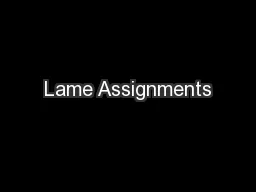PPT-Announcements Working in pairs is only allowed for programming assignments and not for
Author : accouther | Published Date : 2020-06-23
H3 has been posted 1 Syntax Directed Translation 2 CFGs so Far CFGs for Language Definition The CFGs weve discussed can generatedefine languages of valid strings
Presentation Embed Code
Download Presentation
Download Presentation The PPT/PDF document "Announcements Working in pairs is only a..." is the property of its rightful owner. Permission is granted to download and print the materials on this website for personal, non-commercial use only, and to display it on your personal computer provided you do not modify the materials and that you retain all copyright notices contained in the materials. By downloading content from our website, you accept the terms of this agreement.
Announcements Working in pairs is only allowed for programming assignments and not for: Transcript
Download Rules Of Document
"Announcements Working in pairs is only allowed for programming assignments and not for"The content belongs to its owner. You may download and print it for personal use, without modification, and keep all copyright notices. By downloading, you agree to these terms.
Related Documents









![[FREE]-c programming textbook.c programming book.c programming language.c programming.c](https://thumbs.docslides.com/979920/free-c-programming-textbook-c-programming-book-c-programming-language-c-programming-c-programming-visual-quickstart-guide-c-programming-for-dummies-absolute-beginner-s-beginner-exercises-in-easy-steps.jpg)
![[eBOOK]-Programming 19:C Programming Professional Made Easy & Excel Shortcuts (Excel Programming,](https://thumbs.docslides.com/980131/ebook-programming-19-c-programming-professional-made-easy-excel-shortcuts-excel-programming-microsoft-excel-python-for-beginners-c-programming-c-programming-languages-android-c-programming.jpg)
